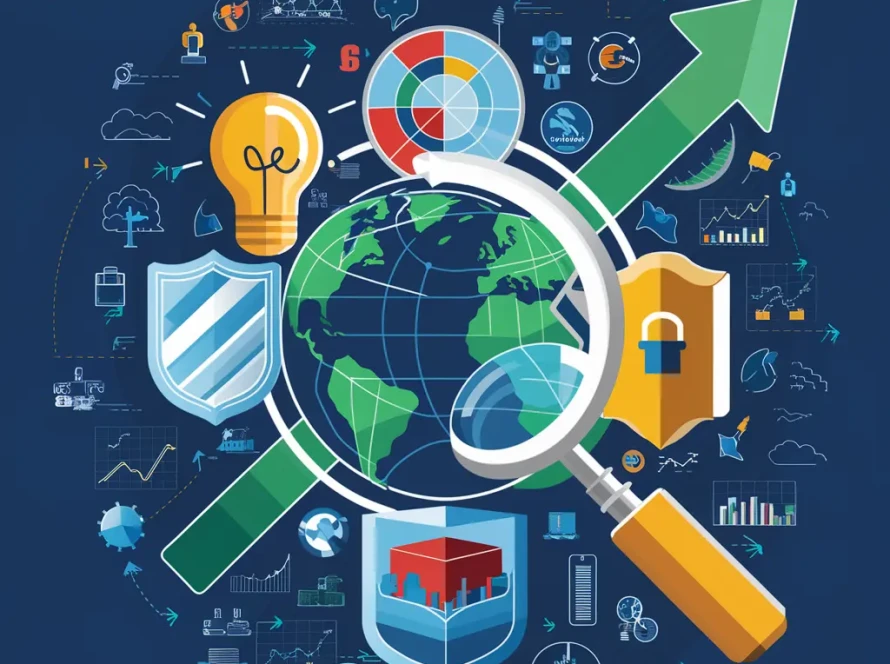Introduction
Generative AI for business intelligence is revolutionizing how companies analyze data and make decisions. If you’re looking for a quick understanding, here’s a snapshot:
- Automation: Speeds up repetitive BI tasks.
- Personalization: Tailors insights from data.
- Efficiency: Saves time and resources.
- Decision-Making: Improves data-driven decisions.
In today’s world, leveraging generative AI for business intelligence can transform how businesses operate. Generative AI uses advanced models to automate data collection, analysis, and even content creation, freeing up time and resources for more strategic tasks.
For example, tools like Seek.ai can turn natural language queries into precise database searches, offering instant insights without coding knowledge. This means small business owners can make informed decisions swiftly, even without a dedicated data science team.
Generative AI also enhances data preparation, from cleansing to validation, ensuring high-quality and relevant data. This minimizes errors and biases, leading to more reliable insights.
Generative AI isn’t just another tech buzzword; it’s a practical tool that can take your business intelligence to the next level.

Understanding Generative AI in Business Intelligence
Generative AI is revolutionizing the field of business intelligence (BI). But what exactly is it, and how does it change the game for business analysis and data-driven decisions?
What is Generative AI?
Generative AI refers to a type of artificial intelligence that can create new data or content based on the patterns it has learned from existing data. Unlike traditional AI, which might classify or predict based on data, generative AI can generate new insights, reports, and even visualizations.
Think of it as an intelligent assistant that doesn’t just answer your questions but also provides insights you hadn’t thought to ask.
How Does Generative AI Enhance Business Analysis?
Business analysis often involves sifting through mountains of data to find actionable insights. Traditionally, this required significant time and expertise. Generative AI changes this by automating many of these tasks.
-
Automated Data Preparation: Generative AI can automate data preparation tasks like tagging, segmentation, and cleaning. According to Crowd Flower, data scientists spend 51% of their time labeling, cleaning, and organizing data. Generative AI can drastically cut down this time, freeing up your team for more strategic tasks.
-
Personalized Insights: Generative AI can analyze historical data to offer personalized recommendations. For instance, finance companies can use it to analyze market data and propose new trading strategies.
-
Proactive Reporting: Rather than waiting for you to ask, generative AI can proactively identify trends and anomalies in your data. This means you get insights faster and can act on them sooner.
Making Data-Driven Decisions Easier
One of the most significant benefits of generative AI is how it democratizes data-driven decision-making. You no longer need to be a data scientist to understand complex data sets.
-
Natural Language Queries: Tools like Seek.ai allow you to interact with your data using natural language queries. You can ask simple questions like, “What were our sales last quarter?” and get detailed, accurate answers without writing a single line of code.
-
Real-Time Alerts: Generative AI can set up automatic notifications for changes in customer behavior or sales. This means you can respond to market shifts in real-time, saving time and potentially avoiding revenue loss.
-
Enhanced Decision-Making: By providing high-quality and relevant data, generative AI minimizes errors and biases, leading to more reliable insights. This ensures that your decisions are based on the best possible information.
Case Study: Seek.ai
Seek.ai exemplifies how generative AI can transform business intelligence. The tool automates data extraction and analytics through AI-powered database queries. It enables users to query databases, including Microsoft SQL servers, using natural human language. This means you can retrieve insights quickly and efficiently, freeing up more time for your data science teams and increasing your business’s ROI.
In summary, generative AI is not just a buzzword; it’s a transformative tool that makes business intelligence more accessible, efficient, and actionable.

Next, let’s explore the key benefits of integrating generative AI into your business intelligence strategy.
How Generative AI Transforms Business Intelligence
Generative AI is revolutionizing business intelligence (BI) by making it more personalized, automated, and predictive. Let’s break down how this happens.
Personalization
Generative AI tailors insights to fit your specific business needs. Imagine having a business intelligence tool that understands your unique challenges and provides customized recommendations.
For instance, an online store can use generative AI to analyze customer behavior and personalize marketing strategies. The AI can identify why some customers abandon their carts and suggest targeted promotions to encourage purchases.
Automation
AI excels at automating repetitive tasks. This means less time spent on data collection and more time on strategic decisions.
For example, AI-driven tools can automate the updating of customer records and the generation of real-time financial reports. This reduces human error and increases operational efficiency.
Predictive Insights
Predictive analytics is where generative AI truly shines. By analyzing historical data, AI can forecast future trends and behaviors. This allows businesses to anticipate market changes and make informed decisions.
Consider a retail company using AI to predict which products will be in high demand during a holiday season. This enables them to manage inventory more effectively and maximize sales.
In summary, generative AI for business intelligence transforms data into actionable insights, making BI more intuitive and powerful. This technology is not just about crunching numbers; it’s about making smarter, data-driven decisions that drive business growth.
Next, let’s explore the key benefits of integrating generative AI into your business intelligence strategy.
Key Benefits of Integrating Generative AI into BI
Consistency and Reliability
Generative AI brings a new level of consistency and reliability to business intelligence. Unlike traditional BI tools, which can be prone to human error and bias, generative AI algorithms process data uniformly. This ensures that insights are accurate and free from the variability that human analysis might introduce.
For example, Stripe utilized GPT-4 to enhance their user experience and detect fraud more effectively. By automating these processes, they minimized errors and improved the reliability of their data insights.
No-Code Implementation
One of the standout features of generative AI is its no-code implementation. This means you don’t need a team of data scientists to set it up. Generative AI tools are designed to integrate seamlessly into your existing workflows without requiring extensive technical expertise.
For instance, Narrative BI offers a no-code platform that allows users to generate insights and narratives from their data effortlessly. This democratizes data analysis, making it accessible to everyone in the organization, not just IT specialists.
User-Friendly Experience
Generative AI tools are incredibly user-friendly. They often come with intuitive interfaces that make it easy for non-technical users to interact with and understand their data.
Natural Language Processing (NLP) plays a big role here. Users can ask questions in plain English, like “What were our highest sales last quarter?” and get immediate, understandable answers. This reduces the learning curve and encourages more employees to engage with data directly.
Real-World Examples
Let’s look at some real-world examples to see these benefits in action:
- Google AI demonstrated how an advanced retina scan could predict cardiovascular events, showcasing how AI can uncover insights that humans might miss.
- Telus used interactive visualization features to find important insights from customer data, enabling them to create upsell opportunities and build wireless services in profitable locations.
These examples highlight how generative AI not only makes data analysis more accessible but also more insightful and actionable.
Next, we’ll dive into the practical applications of generative AI for business intelligence.
Practical Applications of Generative AI for Business Intelligence
Generative AI is more than just a buzzword; it’s a transformative tool that can elevate your business intelligence (BI) efforts. Let’s explore some practical applications where generative AI can make a significant impact.
Marketing Strategies
Generative AI can revolutionize your marketing strategies by analyzing vast amounts of data to identify trends and patterns. For instance, AI can analyze customer behavior and preferences to create personalized marketing campaigns. This ensures that your marketing messages are tailored to individual customers, increasing engagement and conversion rates.
- Example: A retail company used generative AI to analyze customer purchase history and social media interactions. The AI identified key customer segments and recommended personalized promotions, resulting in a 20% increase in sales.
Customer Experience Enhancement
Enhancing customer experience is crucial for retaining customers and building brand loyalty. Generative AI can help by providing real-time insights into customer behavior and preferences. This allows businesses to proactively address customer needs and improve their overall experience.
- Example: An online store utilized generative AI to analyze why customers abandoned their shopping carts. The AI identified common pain points and suggested improvements, such as easier navigation and personalized recommendations. Implementing these changes reduced cart abandonment by 15%.
Inventory Management
Effective inventory management is essential for minimizing costs and meeting customer demand. Generative AI can predict inventory needs by analyzing historical sales data, current trends, and external factors like seasonality. This ensures that you have the right products in stock at the right time.
- Example: A manufacturing company used generative AI to forecast demand for its products. The AI analyzed past sales data and market trends, enabling the company to optimize its inventory levels. This led to a 30% reduction in excess inventory and a 10% increase in order fulfillment rates.
Lead Scoring Forecasting
Identifying and prioritizing high-quality leads is crucial for sales success. Generative AI can analyze various data points, such as customer interactions and demographics, to predict which leads are most likely to convert. This helps sales teams focus their efforts on the most promising prospects.
- Example: A B2B company implemented generative AI to enhance its lead scoring process. The AI analyzed historical lead data and identified key factors that contributed to successful conversions. As a result, the company saw a 25% increase in lead conversion rates and a more efficient sales process.
These practical applications demonstrate how generative AI can transform business intelligence by providing actionable insights and automating complex tasks.
Next, we’ll address the challenges and ethical considerations of integrating generative AI into your BI strategy.
Addressing Challenges and Ethical Considerations
Data Quality
Data quality is crucial for accurate insights. Poor data can lead to incorrect conclusions, affecting your business decisions. Regular audits and automated data cleansing tools can help maintain high data quality. Establishing strict data entry guidelines also ensures incoming data is accurate and reliable.
Bias Mitigation
AI systems learn from data. If the data contains biases, the AI will reflect those biases. For instance, an AI hiring tool trained on a male-dominated dataset might prefer male candidates. To mitigate bias, use diverse datasets and regularly audit AI decisions for fairness.
In 2015, Google Photos mistakenly labeled black people as “gorillas” due to biased training data. This highlights the complexity of bias in AI. Google fixed this by preventing the system from labeling anything as a gorilla, but the issue underscores the need for diverse, unbiased training data.
Human-AI Collaboration
Human-AI collaboration is essential for effective decision-making. While AI can provide data-driven insights, humans are better at interpreting these insights within a real-world context. For example, AI-generated visualizations can inform decision-making, but humans must ask critical questions to guide the analysis meaningfully.
“Trust is vital in any relationship, including the collaboration between humans and AI,” says Michael Rumiantsau. BI professionals should actively learn about AI technology and involve themselves in a feedback loop to identify limitations and improve AI-generated insights.
These steps will help you address the challenges and ethical considerations of integrating generative AI into your BI strategy.
Next, let’s move on to frequently asked questions about generative AI for business intelligence.
Frequently Asked Questions about Generative AI for Business Intelligence
What is Generative AI in Business Intelligence?
Generative AI in Business Intelligence (BI) refers to the use of advanced AI technologies to create new data insights, narratives, and visualizations. Unlike traditional BI, which typically relies on static dashboards and manual data queries, generative AI proactively provides insights and predicts trends, making data analysis more accessible and intuitive.
Think of it as having an intelligent assistant that not only answers your questions but also tells you what you didn’t know to ask. This revolutionizes how businesses interact with data, making it easier for everyone—from data experts to business managers—to make informed decisions.
How Can Businesses Use Generative AI?
Businesses can use generative AI in various ways to enhance their operations and decision-making processes:
-
Personalized Data Visualization: Generative AI can create unique, interactive visualizations tailored to specific user needs. For example, by analyzing medical images and crafting detailed 3D models of a patient’s anatomy, it allows for personalized surgical planning.
-
Risk and Opportunity Management: AI can simulate different scenarios to identify potential risks before they happen and suggest mitigation strategies. It can also uncover new opportunities for growth, such as entering new markets or launching new products.
-
Marketing Strategies: By analyzing customer data, generative AI can help businesses craft more targeted and effective marketing campaigns. For instance, it can predict customer behavior and preferences, allowing for more personalized marketing efforts.
-
Operational Efficiency: Generative AI can optimize supply chain processes, improve pricing strategies, and enhance overall operational efficiency. For example, AI can replicate real financial transactions to train fraud detection models, improving their accuracy.
What Makes Generative BI Different from Traditional BI?
Generative BI stands out from traditional BI in several key ways:
-
Proactive Insights: Unlike traditional BI, which requires manual data queries, generative BI uses AI to automate insight generation and predict future trends. This makes it easier to uncover hidden insights without needing to know exactly what to look for.
-
No-Code Implementation: Generative BI platforms often feature a no-code setup, allowing for quick and easy integration into existing workflows. This democratizes data analysis, making it accessible to non-technical users.
-
Dynamic and Personalized Dashboards: Traditional BI dashboards are often static and require significant manual effort to update. Generative BI offers dynamic, personalized dashboards that adapt to changing business environments and user needs.
-
Enhanced User Experience: Generative BI provides a more user-friendly experience, with intuitive interfaces and interactive visualizations that make data easier to understand and use.
For example, Narrative BI uses advanced AI to create data-driven narratives that are both informative and actionable. This transforms raw data into engaging storylines, making it easier for decision-makers to understand and act on insights.
By addressing these frequently asked questions, you can better understand how generative AI for business intelligence can transform your data analysis and decision-making processes.
Next, let’s delve into the conclusion and explore how Profit Leap can help you leverage generative AI for your business needs.
Conclusion
As we wrap up our exploration of generative AI for business intelligence, it’s clear that this technology is reshaping how businesses operate, strategize, and grow. At Profit Leap, we understand the transformative power of AI in business consulting and have harnessed it to create our AI business advisor, Huxley.
Huxley is more than just a tool; it’s your business’s co-pilot. By leveraging advanced AI capabilities, Huxley provides tailored advice, precise forecasting, and actionable insights, all designed to evolve as your business grows. This ensures that you are not just reacting to changes but creating them.
Our clients’ success stories speak volumes. Take Michael Solis from TransRide, for example. His business was struggling with unprofitable operations due to a lack of clear forecasting. After implementing our sales forecasting and management tool, his business turned around in just a couple of months. This is the kind of impact Huxley can have on your business.
The future of business is about more than just keeping up with changes; it’s about leading them. At Profit Leap, we are committed to being your partner in this journey. Our blend of artificial and human intelligence ensures that your business is equipped to meet today’s challenges and innovate for tomorrow.
By choosing Profit Leap, you’re not just getting an AI business advisor; you’re gaining a partner dedicated to your sustained success. Let Huxley be the compass that guides your business through the ever-changing landscape towards unparalleled success.
Ready to take the leap? Work with us and let Profit Leap be your guide to a brighter business future.



